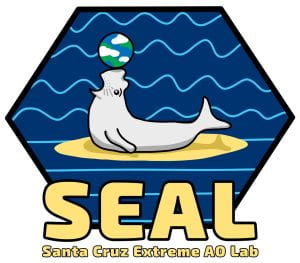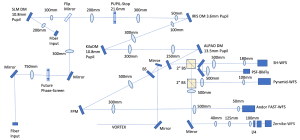 The Santa cruz Extreme AO Lab (SEAL) is a visible-wavelength testbed designed to advance the state of the art in wavefront control for high contrast imaging on large, segmented, ground-based telescopes. SEAL provides multiple options for simulating atmospheric turbulence, including rotating phase plates and a custom Meadowlark spatial light modulator that delivers phase offsets of up to 6pi at 635nm. A 37-segment IrisAO deformable mirror (DM) simulates the W. M. Keck Observatory segmented primary mirror. The adaptive optics system consists of a woofer/tweeter deformable mirror system (a 97-actuator ALPAO DM and 1024-actuator Boston Micromachines MEMs DM, respectively), and four wavefront sensor arms: 1) a high-speed Shack-Hartmann WFS, 2) a reflective pyramid WFS, designed as a prototype for the ShaneAO system at Lick Observatory, 3) a vector-Zernike WFS, and 4) a Fast Atmospheric Self Coherent Camera Technique (FAST) demonstration arm, consisting of a custom focal plane mask and high-speed sCMOS detector. Finally, science arms preliminarily include a vector vortexcoronagraph as well as FAST (which doubles as a WFS and science camera). SEAL’s real time control system is based on the Compute and Control for Adaptive optics (CACAO) package, and is designed to support the efficient transfer of software between SEAL and the Keck II AO system.
The Santa cruz Extreme AO Lab (SEAL) is a visible-wavelength testbed designed to advance the state of the art in wavefront control for high contrast imaging on large, segmented, ground-based telescopes. SEAL provides multiple options for simulating atmospheric turbulence, including rotating phase plates and a custom Meadowlark spatial light modulator that delivers phase offsets of up to 6pi at 635nm. A 37-segment IrisAO deformable mirror (DM) simulates the W. M. Keck Observatory segmented primary mirror. The adaptive optics system consists of a woofer/tweeter deformable mirror system (a 97-actuator ALPAO DM and 1024-actuator Boston Micromachines MEMs DM, respectively), and four wavefront sensor arms: 1) a high-speed Shack-Hartmann WFS, 2) a reflective pyramid WFS, designed as a prototype for the ShaneAO system at Lick Observatory, 3) a vector-Zernike WFS, and 4) a Fast Atmospheric Self Coherent Camera Technique (FAST) demonstration arm, consisting of a custom focal plane mask and high-speed sCMOS detector. Finally, science arms preliminarily include a vector vortexcoronagraph as well as FAST (which doubles as a WFS and science camera). SEAL’s real time control system is based on the Compute and Control for Adaptive optics (CACAO) package, and is designed to support the efficient transfer of software between SEAL and the Keck II AO system.
SEAL Layout:

SEAL Publications:
- Jensen-Clem et al, 2021, SPIE “The Santa Cruz Extreme AO Lab (SEAL): Design and First Light”
- Gerard et al, 2021, SPIE, “The Bright Pyramid Wavefront Sensor”
- Gerard et al, 2021, SPIE, “First experimental results of the fast atmospheric self-coherent camera technique on the Santa Cruz extreme adaptive optics laboratory testbed: demonstration of high speed focal plane wavefront control of residual atmospheric speckles”
- Sengupta et al, 2022, SPIE, “Laboratory demonstration of optimal identification and control of tip-tilt systems”
- Salama et al, 2022, SPIE, “Vector Zernike wavefront sensor on the Santa Cruz Extreme AO Lab (SEAL) testbed”
- van Kooten et al, 2022, SPIE, “Spatial light modulator on Santa Cruz Extreme AO Laboratory (SEAL) testbed”
- Gerard et al, 2022, SPIE, “Various wavefront sensing and control developments on the Santa Cruz Extreme AO Laboratory (SEAL) testbed”
- Gerard et al, “Laboratory Demonstration of Real-Time Focal Plane Wavefront Control of Residual Atmospheric Speckles,” JATIS, 2022
People:
| SEAL PI | Rebecca Jensen-Clem | rjensenc@ucsc.edu |
| LAO Director | Phil Hinz | phinz@ucsc.edu |
| Engineer | Daren Dillon | dillon@ucsc.edu |
| Engineer | Reni Kupke | rkupke@ucolick.org |
| Engineer | Sylvain Cetre | scetre@keck.hawaii.edu |
| Postdoc | Maissa Salama | msalama@ucsc.edu |
| Postdoc | Vincent Chambouleyron | vchambou@ucsc.edu |
| Grad Student | Rachel Bowens-Rubin | rbowru@ucsc.edu |
| Grad Student | Dominic Sanchez | dfsanche@ucsc.edu |
| Grad Student | Jules Fowler | jumfowle@ucsc.edu |
| Grad Student | Jordan Diaz | jdiaz71@ucsc.edu |
| Grad Student | Aditya Sengupta | adityars@ucsc.edu |
| Undergraduate | Javier Perez Soto | jperezso@ucsc.edu |
Alumni: Former postdoc Benjamin L. Gerard is now a research scientist at Lawrence Livermore National Laboratory. Former postdoc Maaike van Kooten is now an adaptive optics developer at NRC Herzberg Astronomy and Astrophysics Research Centre.